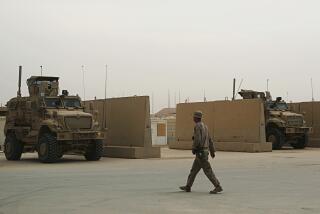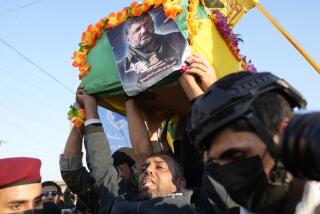Trainers say Iraqi forces would collapse without U.S. support
BESMAYA RANGE, IRAQ — Teams of Iraqi soldiers huddled outside the doors of two small homes across a narrow road from each other. Their AK-47s were ready, and so were they.
They kicked in the doors of each house, burst in, and began searching the rooms for insurgents, aiming their weapons as they moved crab-like through the maze-like structures.
“Stop! Stop! Stop!” someone hollered in English from a catwalk above them.
It was U.S. Army 1st Lt. Andrew Fuller, trying to break the soldiers of a potentially lethal habit. Simultaneous, side-by-side searches such as these often can end up with soldiers pointing their guns at each other.
“You always want to have your clearing operations going in the same direction,” Fuller explained through a translator as the Iraqi teams regrouped in the dusty alley to try another approach.
For almost three years, training the Iraqi army has been among the top priorities for the U.S. military. And for nearly that long, U.S. officials have considered it among their chief frustrations.
Now, with President Bush under steady pressure to begin pulling U.S. troops from Iraq, the administration once again is emphasizing the need to train Iraqi forces to take over the country’s security.
But despite some signs of progress, both Iraqis and their American advisors at this training range are blunt about how much work remains: If a U.S. pullout comes anytime soon, most say, the Iraqi army will collapse.
“Honestly put, I think Iraq would be challenged to remain a unified country,” said Marine Lt. Col. William Redman, the senior advisor at the range.
“I’ve seen anarchy, and we’re right on the brink of it right now. If we go in a year or two years, it’s going to be a complete mess,” said retired Army 1st Sgt. Jerry Massey, a 21-year veteran who trains Iraqis in how to spot and respond to threats. “We can’t leave here for another five years, minimum.”
Leaving too soon means different things to different people at Besmaya, a former Iraqi army base sprawling across a wind-ravaged stretch of khaki-colored desert in southwestern Diyala province. The base now is dedicated to training Iraqi troops, who come here for three weeks of intensive training before being deployed to the capital to enforce the U.S.-Iraqi security crackdown launched in mid-February.
Most, though, agree that for a variety of reasons it will be years before the Iraqis are ready to stand on their own.
Chief among them is the disintegration of Iraq’s security, which has created a nation plagued by sectarian violence as well as an insurgency that includes groups loyal to Al Qaeda in Iraq. The insurgency has drawn in foreign fighters with a level of sophistication outweighing that of most Iraqi forces.
Troops in the all-volunteer Iraqi army have proved unpredictable. Many signed up with the idea that they would remain close to home, explained Gen. Ali Ghidan Majeed, the commander of ground troops in Iraq’s army. Instead, because of the widening violence, they are being deployed to Baghdad, Al Anbar province and other far-flung places. That is driving some to desert, Majeed said.
In addition, pay is low and sometimes doesn’t come at all because of administrative delays, which Majeed said leads many troops to take their monthly home leave and not return to duty.
“We’re moving forward step by step,” he said during a visit to Besmaya. “But my message is we need the coalition forces here in Iraq. We need them a lot: to manage our training, to manage our supplies, to manage our army.”
That’s not the message that President Bush and other backers of the war want to send. Though they oppose legislation demanding a timetable for U.S. troop withdrawal, they also face growing public opposition to the war, in which at least 3,355 U.S. troops have been killed since March 2003, according to the website icasualties.org, which tracks American casualties in the war.
Nobody denies that progress has been made in improving the Iraqi military. The army has 10 divisions, and trainers say new recruits show a commitment to learn and to serve that far outshines most older officers’ attitudes.
Many continue to train and serve, even without pay, and the Besmaya range offers state-of-the-art facilities to make them better soldiers. While here, they are away from the distractions of home. Even their cellular phones are taken away.
Majeed acknowledged that sectarian divisions exist in the army, but he said this branch of Iraq’s security forces was far more cohesive than others.
“You’ve got to take this in context,” said U.S. Army Brig. Gen. Dana Pittard, who oversees teams of U.S. troops who are working and living alongside Iraqi forces to boost their battlefield performance.
“In early 2005, there were two struggling Iraqi army divisions. Now we have 10 very capable divisions, and we’re working on 11 and 12. So over the past two years there has been a huge amount of progress, but we’re not there yet,” he said.
Whether it was the off-key bugle tones that greeted the Iraqi and U.S. generals at Besmaya, or the assessment of field training exercises, the obstacles facing the Iraqis and their U.S. advisors were evident.
One of the biggest challenges, Fuller explained, is giving directions to Iraqis without violating cultural traditions that frown upon yelling orders. The in-your-face attitude that is effective at making U.S. trainees learn quickly is unacceptable here, particularly coming from someone as young as Fuller, who is 25.
If a soldier is struggling to catch on, advisors must take him aside and, through a translator, explain quietly what needs to change. This takes time, and there is little time to get these troops in shape for the dangers of Baghdad.
On an obstacle course designed to give soldiers an idea of what they will face in the field, Massey conducts drills to break bad habits. Chief among them is the tendency of Iraqi soldiers not to take cover when they come under fire. Dolls painted to resemble armed insurgents pop up from the sand via a remote control device in Massey’s vehicle. “They like to hang out and shoot at the targets,” Massey said.
The Iraqis also have not developed the close-knit teamwork that is drilled into U.S. forces, he said, citing their behavior during drills to simulate a roadside bomb exploding near a convoy.
U.S. troops are trained to provide cover to the stricken vehicle.
“The Iraqis do something totally different,” Massey said. “They just haul butt out of there.” That leaves the stranded vehicle alone to face the barrage of gunfire that generally follows a roadside bombing, and virtually guarantees casualties.
Fuller said another problem he sees is the corruption and laziness of older officers who served under former dictator Saddam Hussein.
“But now we’re starting to see a lot of younger officers step up, and they’re making a big impact,” he said.
One such newcomer is Sgt. Mohammed Khamis, part of the Iraqi battalion from Kirkuk that was in its final days of training for Baghdad. Other than pay issues, Khamis said, the men with him were ready to do anything and go anywhere. Still, he said they were not ready to go it alone.
He said Iraqis still needed the Americans on the streets of Baghdad.
Even the biggest optimists, such as Pittard, say it is the duty of the U.S. to ensure that the mess arising since Hussein’s ouster does not destroy Iraq.
“We came here in 2003. We cannot leave ... this nation as a failed state in disarray. I think it would go in that direction,” Pittard said. He said it would be January before one could judge progress of the Baghdad security plan alone, much less Iraqi troops’ readiness to take charge of the entire country.
The Iraqi commander at Besmaya, Col. Abbas Fadhil, agreed. Fadhil was the first soldier to sign up in the new Iraqi army, on July 21, 2003, and echoes White House accusations that much of the violence plaguing Iraq now is being fueled by Iran. If the United States were to leave, Iran would move in and devour Iraq, he said.
“Without America? Fighting alone? Just Iraqi army fighting? That’s not good,” Fadhil said, his eyes widening at the thought. “We need time for training, for supplies. We need at least seven years.” Even better, he said, 50 years.
*
More to Read
Sign up for Essential California
The most important California stories and recommendations in your inbox every morning.
You may occasionally receive promotional content from the Los Angeles Times.











